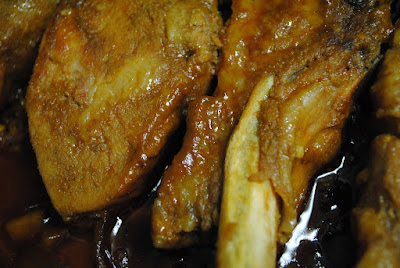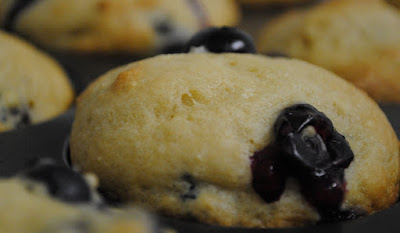I admit it, I've been on a extra bit of a bread kick recently. It's just that if you buy only one loaf of store-bought, pre-sliced bread per week, and you and your 'Chefski use it all up on Sunday making that week's lunch for two, a bread-lover like me can get a little antsy. After attacking the fruit stash or making a smoothie, I'm still left craving bread as a snack. At least that's one explanation for my baking-fixation.
When I told my mother that I'd baked yet another loaf of bread the other day, she reasoned that it's probably because in many ways I take after my father, and as she is often quick to remind me, those on his side of the family are in constant need of creating something with their hands. My father used to take apart and build things all the time, and all of his siblings have some kind of hands-on hobby or job, be it repairing old cars, doing people's hair, or drawing and painting. I guess my contribution to the family tradition is making food for fun and not just for feeding.
I chose to tackle my first pumpernickel because I wanted to use some of the rye flour I'd gotten a while back, and I'm pretty happy with the results (check out the cool dots that accidentally formed in the process). In the future I think I'll try a sourdough version and maybe throw in some caraway seeds for a more typical American pumpernickel taste.
Pumpernickel Bread
Adapted from Smitten Kitchen
Ingredients
1 cup warm tap water
2 1/2 teaspoons active dry yeast
2 cups unbleached, all purpose flour
1/2 cup whole wheat flour
1/2 cup whole grain rye flour
1 Tablespoon non-alkalized cocoa powder
2 teaspoons salt
1 Tablespoon unsulfured molasses
cornmeal for sprinkling bottom of loaf
heavy baking pan
Directions
1. In a medium bowl, whisk together water and yeast, and let sit for 5 minutes to activate.
2. Add molasses, and all purpose, whole wheat, and rye flours, as well as the cocoa and salt. Stir well to incorporate all the ingredients.
3. Once well-mixed, knead by hand for a few minutes to form an elastic and smooth dough.
4. Place dough in a well-oiled bowl and cover with plastic wrap. Let dough rise at room temperature until doubled.
5. Turn out dough onto a lightly floured surface and form into a round loaf by shaping into a sphere and tucking the dough under until you've created a smooth loaf. Here's how I got those cool dots: if you've got a special baking basket, invert your dough onto a heavily-floured napkin placed inside said basket. If you're like me and don't have one, just place a sheet of Bounty in a bowl, heavily flour it, and invert your dough into the bowl. Cover with plastic wrap and allow to rise until doubled. The dough rises into the basket (or bounty) and takes on the indentations of whatever's under it.
6. When your dough is almost done rising, preheat your oven to 500 degrees F. Be sure your rack is in the middle of the oven.
7. Sprinkle some cornmeal on a baking pan (since I have no baking stone), invert your loaf onto the pan, and score the top of your loaf using a sharp knife (I made an "X" shape, but some bread bakers get really creative with this step and make some great patterns). Feel free to sprinkle some cornmeal on top for good measure. Place in oven.
8. Lower your oven's temperature to 450 degrees F and bake for 40 minutes. I know my dough was particularly dense on the day I made it, so check for doneness/ add a few minutes if necessary so that you don't have raw bread.
9. Remove from oven and place on a wrack to cool. As soon as it was no longer steaming hot (but still warm), I enjoyed it quite thoroughly with a little butter.
3. Once well-mixed, knead by hand for a few minutes to form an elastic and smooth dough.
4. Place dough in a well-oiled bowl and cover with plastic wrap. Let dough rise at room temperature until doubled.
5. Turn out dough onto a lightly floured surface and form into a round loaf by shaping into a sphere and tucking the dough under until you've created a smooth loaf. Here's how I got those cool dots: if you've got a special baking basket, invert your dough onto a heavily-floured napkin placed inside said basket. If you're like me and don't have one, just place a sheet of Bounty in a bowl, heavily flour it, and invert your dough into the bowl. Cover with plastic wrap and allow to rise until doubled. The dough rises into the basket (or bounty) and takes on the indentations of whatever's under it.
6. When your dough is almost done rising, preheat your oven to 500 degrees F. Be sure your rack is in the middle of the oven.
7. Sprinkle some cornmeal on a baking pan (since I have no baking stone), invert your loaf onto the pan, and score the top of your loaf using a sharp knife (I made an "X" shape, but some bread bakers get really creative with this step and make some great patterns). Feel free to sprinkle some cornmeal on top for good measure. Place in oven.
8. Lower your oven's temperature to 450 degrees F and bake for 40 minutes. I know my dough was particularly dense on the day I made it, so check for doneness/ add a few minutes if necessary so that you don't have raw bread.
9. Remove from oven and place on a wrack to cool. As soon as it was no longer steaming hot (but still warm), I enjoyed it quite thoroughly with a little butter.

























